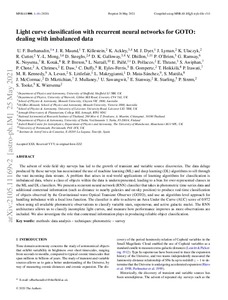Light-curve classification with recurrent neural networks for GOTO: dealing with imbalanced data
Burhanudin UF; Maund JR; Killestein T; Ackley K; Dyer MJ; Lyman J; Ulaczyk K; Cutter R; Mong YL; Steeghs D; Galloway DK; Dhillon V; O'Brien P; Ramsay G; Noysena K; Kotak R; Breton RP; Nuttall L; Palle E; Pollacco D; Thrane E; Awiphan S; Chote P; Chrimes A; Daw E; Duffy C; Eyles-Ferris R; Gompertz B; Heikkila T; Irawati P; Kennedy MR; Levan A; Littlefair S; Makrygianni L; Mata-Sanchez D; Mattila S; McCormac J; Mkrtichian D; Mullaney J; Sawangwit U; Stanway E; Starling R; Strom P; Tooke S; Wiersema K
Light-curve classification with recurrent neural networks for GOTO: dealing with imbalanced data
Burhanudin UF
Maund JR
Killestein T
Ackley K
Dyer MJ
Lyman J
Ulaczyk K
Cutter R
Mong YL
Steeghs D
Galloway DK
Dhillon V
O'Brien P
Ramsay G
Noysena K
Kotak R
Breton RP
Nuttall L
Palle E
Pollacco D
Thrane E
Awiphan S
Chote P
Chrimes A
Daw E
Duffy C
Eyles-Ferris R
Gompertz B
Heikkila T
Irawati P
Kennedy MR
Levan A
Littlefair S
Makrygianni L
Mata-Sanchez D
Mattila S
McCormac J
Mkrtichian D
Mullaney J
Sawangwit U
Stanway E
Starling R
Strom P
Tooke S
Wiersema K
OXFORD UNIV PRESS
Julkaisun pysyvä osoite on:
https://urn.fi/URN:NBN:fi-fe2021093048496
https://urn.fi/URN:NBN:fi-fe2021093048496
Tiivistelmä
The advent of wide-field sky surveys has led to the growth of transient and variable source discoveries. The data deluge produced by these surveys has necessitated the use of machine learning (ML) and deep learning (DL) algorithms to sift through the vast incoming data stream. A problem that arises in real-world applications of learning algorithms for classification is imbalanced data, where a class of objects within the data is underrepresented, leading to a bias for overrepresented classes in the ML and DL classifiers. We present a recurrent neural network (RNN) classifier that takes in photometric time-series data and additional contextual information (such as distance to nearby galaxies and on-sky position) to produce real-time classification of objects observed by the Gravitational-wave Optical Transient Observer, and use an algorithm-level approach for handling imbalance with a focal loss function. The classifier is able to achieve an Area Under the Curve (AUC) score of 0.972 when using all available photometric observations to classify variable stars, supernovae, and active galactic nuclei. The RNN architecture allows us to classify incomplete light curves, and measure how performance improves as more observations are included. We also investigate the role that contextual information plays in producing reliable object classification.
Kokoelmat
- Rinnakkaistallenteet [27094]
